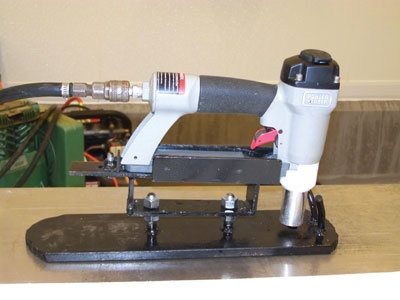
A Simple Option
By Kim Waalderbos
Features Equipment Housing Poultry Equipment Research Poultry Research ResearchThe Zephyr stun gun could provide a humane way to euthanize birds
 “The tool really proved to be effective, quick and easy to use,” says Jane Morrigan, co-researcher and animal welfare training and auditing specialist for Integrity Livestock Services.
“The tool really proved to be effective, quick and easy to use,” says Jane Morrigan, co-researcher and animal welfare training and auditing specialist for Integrity Livestock Services. Poultry farmers and abattoirs could have a humane alternative for euthanizing spent or market-ready birds.
Animal science researchers at the Dalhousie University Faculty of Agriculture (formerly the Nova Scotia Agricultural College) have assessed a tool called the Zephyr – a non-penetrating pneumatic stun gun – for use on broilers and layers.
They say that the Zephyr gun could be a humane method for poultry euthanasia.
“This tool is a win-win,” says Jane Morrigan, co-researcher and animal welfare training and auditing specialist for Integrity Livestock Services. “It’s humane for the animal, quiet and easy to use for the farm worker or research technician.”
The University of Guelph and the Ontario Ministry of Agriculture, Food and Rural Affairs developed the tool, based on a model imported from the United Kingdom, to stun rabbits in processing plants. The Zephyr is a non-penetrating captive bolt stunner driven by compressed air that has been shown to work for all weights and sizes of rabbits.
After learning about the Zephyr, Morrigan first supervised Nichelle Peck for her fourth-year student research project to study its effectiveness for fish euthanasia at the college’s Aquaculture Research Centre, with very positive results. She then turned her attention to its use in poultry, teaming with fourth-year animal science student Samantha Canning and Dr. Bruce Rathgeber of the Atlantic Poultry Research Institute to assess its effectiveness.
Their primary goal was to determine whether the Zephyr could deliver enough force to the skull to render the animal instantly insensible and free of pain – a necessity in ensuring humane euthanasia. Morrigan says they also compared the operator’s experience level, and tried to determine if the positioning of the Zephyr on the bird’s head had an effect.
To complete the research, Morrigan says they used 67 birds, a mix of broilers and laying hens. The Animal Care Committee at the university would not allow the initial research to be conducted on live birds, so the team worked with post-mortem birds just after they were stunned in a conventional electric stun bath.
Morrigan says that while it is unfortunate not to have studied the effects on live birds, their post-mortem work did enable them to assess the severity of trauma to the skull. She reasoned that a fractured skull is a good predictor of instantaneous loss of consciousness – and therefore absence of pain. Immediately after the birds were stunned in the electric stun bath, they were weighed and the Zephyr was applied to the top of the head, twice in quick succession, using air compressed at 120 pounds per square inch.
Six different factors were compared: the strain of bird, their weight, comb size, operator experience, position on head, amount of skull fracture and damage to the brain (after dissection).
Their results show that the Zephyr could provide enough trauma to the skull to render the bird instantly unconscious, says Morrigan, and the optimal spot for positioning the Zephyr was determined to be behind the comb. Laying hens averaged the largest fracture, though their skulls tend to be smaller, she adds. Also, the experience level of the person operating the Zephyr had no significant effect on skull fracture and brain damage.
“The tool really proved to be effective, quick and easy to use,” says Morrigan, adding that the predetermined force takes the guesswork out for the farm worker, which in turn helps to reduce any anxiety that is experienced when faced with having to perform euthanasia.
Morrigan says they’ve learned that the Zephyr works smoothly when two people are working together, one to hold the bird upright with wings held close to the bird’s body and the other to move the head on a solid table or bench and position the Zephyr. It’s important to ensure that the head is positioned against something firm and solid to prevent head movement, she says. “We lay the head gently so the chin is resting on a solid table or bench.”
Morrigan says they found that applying one percussive force correctly behind the comb was enough, but applying two in quick succession can provide extra assurance. It is also important to also keep the Zephyr clean after the day’s use to prevent it from gumming up, she adds.
Following the Zephyr’s trial, Morrigan says their research technicians were so satisfied with its performance that they purchased the stun gun to continue using it in their facility. The tool has also been distributed through a number of programs to rabbit processing plants throughout Canada.
“It’s an impressive tool,” she says. “I would love to someday see this tool in every laying house and broiler barn. In addition to the gun itself, all that is needed is a small compressor and five minutes of training.”
Researchers at the Prairie Swine Centre have also recently tested the Zephyr and found it to be an effective tool for euthanizing piglets ranging in size from three to nine kilograms. They have also retained the tool for any ongoing euthanasia needs, post-research project.
The University of Guelph developers are currently seeking a company that can oversee commercial-scale development of the Zephyr gun, so that fish farms, poultry and swine operations can purchase their own at an affordable cost. Current models have been provided for research projects with support from the Canadian Farm Animal Care Trust.
Print this page